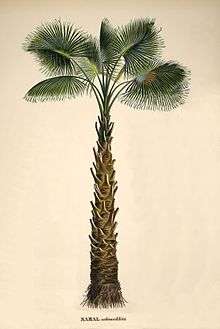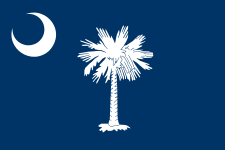Sabal palmetto
| cabbage palmetto | |
|---|---|
| | |
| Sabal palmetto in habitat, Florida | |
| Scientific classification | |
| Kingdom: | Plantae |
| (unranked): | Angiosperms |
| (unranked): | Monocots |
| (unranked): | Commelinids |
| Order: | Arecales |
| Family: | Arecaceae |
| Subfamily: | Coryphoideae |
| Tribe: | Sabaleae |
| Genus: | Sabal |
| Species: | S. palmetto |
| Binomial name | |
| Sabal palmetto (Walt.) Lodd. | |
| Synonyms[1][2] | |
|
Synonymy
| |

Sabal palmetto, also known as cabbage palm,[1] palmetto, cabbage palmetto,[1] palmetto palm, blue palmetto,[1] Carolina palmetto,[3] common palmetto,[3] swamp cabbage[4] and sabal palm, is one of 15 species of palmetto palm (Arecaceae, genus Sabal). It is native to the subtropical Gulf coast/south Atlantic coast of the USA, as well as Cuba,[5] the Turks & Caicos Islands, and The Bahamas.[5][6][7]
In the United States the native range of Sabal palmetto is the coastal plains of the Gulf states and south Atlantic states from Cape Fear, North Carolina south to Florida, though a disjunct population occurs in Cape Hatteras, North Carolina.[8][9][10] It is the state tree of both South Carolina and Florida.
Description
Sabal palmetto grows up to 65 ft (20 m) in height (with exceptional individuals up to 92 ft (28 m) in height, with a trunk up to 2 ft (60 cm) diameter. It is a distinct fan palm (Arecaceae tribe Corypheae), with a bare petiole which extends as a center spine or midrib, (costa) 1/2 to 2/3 the length into a rounded, costapalmate fan of numerous leaflets. A costapalmate leaf has a definite costa (midrib) unlike the typical palmate or fan leaf, but the leaflets are arranged radially like in a palmate leaf. All costapalmate leaves are markedly recurved or arched backwards. Each leaf is 5 to 6.5 ft (1.5–2 m) long, with 40-60 leaflets up to 2.6 ft (80 cm) long.
The flowers are yellowish-white, .20 in (5 mm) across, produced in large compound panicles up to 8.2 ft (2.5 m) long, extending out beyond the leaves. The fruit is a black drupe about .5 in (1.3 cm) long containing a single seed. It is extremely salt-tolerant and is often seen growing near both the Atlantic Ocean coast and the Gulf of Mexico coast.[11]
Sabal palmetto is hardy to USDA zone 8, and has been reported to have some cold hardness down to -13 C (7 F). Maintenance of the Cabbage Palm tree is very easy and very adaptable. The cabbage palmetto is known to tolerate drought, standing water and brackish water. Even though this palm is drought-tolerant, it thrives on regular light watering and regular feeding. It is highly tolerant of salt winds, but not saltwater flooding.[12]
Historical background
The cabbage-like terminal bud has been eaten as hearts of palm. The bristles on the sheaths of young leaves have been made into scrubbing brushes. The trunks have been used as wharf piles. On June 28, 1776, Charleston patriots under William Moultrie made a fort of palmetto trunks and from it defended successfully against the British in the Revolutionary War.[13]
Cultivation and uses
Sabal palmetto is a popular landscape plant known for its tolerance of salt spray and cold. Because of their relatively long establishment period and prevalence on ranchlands, few, if any are grown from seed in nurseries. Instead, established plants are dug in the wild with small rootballs since virtually all the severed roots die and must be replaced by new roots in the new location. Most leaves are removed at this time to reduce transpiration. It is the state tree of South Carolina and Florida. Most references rate the species as hardy to USDA hardiness zone 8a. They have been successfully grown as far north as Virginia and even southern Delaware. Cabbage palms have excellent hurricane resistance, but are frequently over-pruned for a variety of reasons.
The growing heart of the new fronds, also known as the terminal bud, gives the tree its "cabbage" name, since this is extracted as a food and tastes like other undifferentiated plant meristem tissue, such as the heart of a cabbage or artichoke. It is one of several palm species that is sometimes used to make heart of palm salad. Heart of palm was commonly eaten by Aboriginal Americans. However, extracting the heart will kill this species of palm, because the terminal bud is the only point from which the palm can grow and without this bud the palm will not be able to replace old leaves and will eventually die.
The cabbage palm is remarkably resistant to fire, floods, coastal conditions, cold, high winds and drought. Despite this, alarming causes of recent mortality include rising sea level (most noticed on the Big Bend Coast of Florida), and Texas phoenix palm decline (TPPD) a phytoplasma currently found on the west coast of Florida.
Sabal palmetto trunks appear in two different conditions, which can be confusing (see photo). When leaves die, the leaf bases typically persist for a while, creating a spiky, "basketweave" effect. These remnant leaf bases are called "bootjacks" or "boots", for short. The name stems from the "Y" shape that was reminiscent of devices used to aid individuals in removing boots. Transplanted palms are sometimes deliberately shorn of these bootjacks. Taller specimens are more likely to have lost their bootjacks and appear relatively smooth and columnar. The loss of bootjacks is a natural, if poorly understood, phenomenon as the palm does not create a leaf abscission zone so the loss of the leaf bases results from some other physical or biological process.
Sabal 'Lisa'

Recently, a new mutant form of Sabal palmetto has been discovered in South West Florida, and named as a cultivar Sabal palmetto 'Lisa'. The difference between the 'Lisa' and the wild-type Sabal palmetto is in the form of the leaf. The 'Lisa' has leaves that are costapalmate, acute, not pendulous, not filamentose, rigid, not strongly divided, cupped, and slightly undulating. This mutation of Sabal palmetto is beginning to be seen in the nursery trade, as it is just as hardy to cold, salt, drought, fire and wind as the wild type of the species, but looks different. Two specimens can be seen in Fort Myers, Florida at the intersection of Luckett Road and I-75, and many seed is collected and distributed from these specimens. Seeds from Sabal palmetto 'Lisa' have a 68% chance of becoming true to type, the other 32% develop as the wild type.[14]
Symbolic use


A silhouette of a palmetto (S. palmetto) appears on the official flag of the US State of South Carolina.[15] Two palmettos (S. palmettos) appear in the official great seal of the US State of Florida.[16]
Photos
-

Sabal palmetto shows remarkable tolerance of salt, even being able to grow where washed by sea water at high tide. Note the palm in the forefront has not had the "boots" removed, while the palm to the far right has. Virginia Beach, Virginia
-
Sabal palmetto growing near the South Carolina state capitol in Columbia -

Up close shot of Sabal 'Lisa' showing leaf character, distinct from that of wild-type Sabal palmetto
-
Palm tree in the Canaveral National Seashore
-
Bootjacks
See also
References
- 1 2 3 4 John H. Wiersema. "USDA GRIN taxonomy". Ars-grin.gov. Retrieved 2014-03-22.
- ↑ Kew World Checklist of Selected Plant Families
- 1 2 "US Forest Service Silvics Manual: ''Sabal palmetto''". Na.fs.fed.us. Retrieved 2014-03-22.
- ↑ James M. Stephens (1994). "Cabbage, Swamp — Sabal palmetto (Walt.) Lodd ex Schult. & Schult.f., Fact Sheet HS-571" (PDF). University of Florida, Florida Cooperative Extension Service.
- 1 2 Van Deelen, Timothy R. 1991. Sabal palmetto. In: Fire Effects Information System, [Online]. U.S. Department of Agriculture, Forest Service
- ↑ Zona, S. (1990). "A monograph of Sabal (Arecaceae: Coryphoideae)". Aliso (Rancho Santa Ana Botanic Garden) 12: 583–666.
- ↑ Biota of North America Program 2014 county distribution map
- ↑ Diana L. Immel (2001). "Cabbage Palmetto Sabal palmetto (Walt.) Lodd. ex J.A. & J.H. Schultes" (PDF). United States Department of Agriculture, Natural Resources Conservation Service.
- ↑ "USDA PLANTS database".
- ↑ Dale D. Wade & Gordon Langdon. "Cabbage Palmetto".
- ↑ Flora of North America: Sabal palmetto
- ↑ "Real Palm Trees". Palm Tree General Description.
- ↑ Peattie, Donald Culross. Trees You Want to Know. Whitman Publishing Company, Racine, Wisconsin, 1934. p36
- ↑ "A new cultivar of Sabal palmetto" (PDF). Palm Tree General Description.
- ↑ Netstate, South Carolina State Flag
- ↑ The Great Seal of the State of Florida
External links
| Wikimedia Commons has media related to Sabal palmetto. |
- Sabal palmetto from Floridata
- Interactive Distribution Map for Sabal palmetto
-
 Chisholm, Hugh, ed. (1911). "Palmetto". Encyclopædia Britannica 20 (11th ed.). Cambridge University Press. p. 649.
Chisholm, Hugh, ed. (1911). "Palmetto". Encyclopædia Britannica 20 (11th ed.). Cambridge University Press. p. 649.
